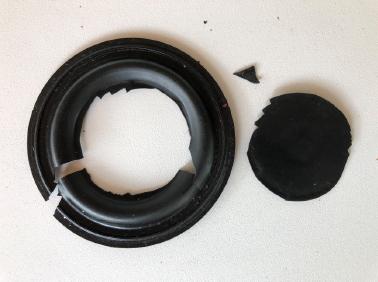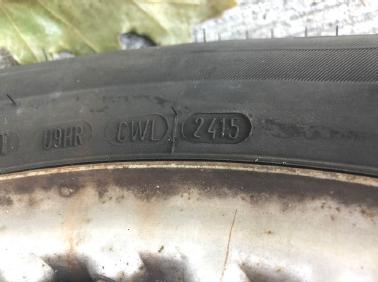 TechTip #4
TechTip #4
“The clock is always ticking with rubber!!”
 Rubber is one of those things that age with time and not miles driven. It gets hard and brittle as this rather Rubber is one of those things that age with time and not miles driven. It gets hard and brittle as this rather
| |

Rubber gets brittle as it ages, falling apart
|
extreme example of an MGB positive crankcase ventilation valve show. It’s always a good idea the do at least an annual inspection of rubber hoses, fuel, brake, clutch and coolant, bending them and looking for cracks and hardness ( and leaks of course!!). When we do a “return to the road” project we inevitably replace these rubber components.
 Tyres are probably one of the most abused examples of this neglect. In the case of the P.C.V. valve the car just won’t run quite right. In the case of tyres not gripping the road the consequences could be far worse………………. Tyres are probably one of the most abused examples of this neglect. In the case of the P.C.V. valve the car just won’t run quite right. In the case of tyres not gripping the road the consequences could be far worse……………….
 Ten years is the generally accepted usable life of a tyre. Once they get to that age they should be replaced even if they look great, have plenty of tread on them and no signs of cracking. Ten years is the generally accepted usable life of a tyre. Once they get to that age they should be replaced even if they look great, have plenty of tread on them and no signs of cracking.
 Tyres have a manufacturing date code molded onto one side of the sidewall. All our cars should have a four-digit code on them by now. A three-digit code means the tyre was made before the year 2000!! Tyres have a manufacturing date code molded onto one side of the sidewall. All our cars should have a four-digit code on them by now. A three-digit code means the tyre was made before the year 2000!!
| |

According to the date code (2415), this tire is over 7 yrs old
|
 The first two digits of the code give the week number of manufacture and the second two the year. For example, 1520 would mean the tyre was made in week fifteen of 2020. Of course, the code maybe on the inside of the wheel and not the outside, making checking it a lot harder! The first two digits of the code give the week number of manufacture and the second two the year. For example, 1520 would mean the tyre was made in week fifteen of 2020. Of course, the code maybe on the inside of the wheel and not the outside, making checking it a lot harder!
 The second picture shows the date code on my 1970 MGB GT, 2415. So, they are a little over 7 years old now and getting up there in age. It will be time to replace them soon. The second picture shows the date code on my 1970 MGB GT, 2415. So, they are a little over 7 years old now and getting up there in age. It will be time to replace them soon.
Steve Skegg
Technical Coordinator
Editor Note: Steve is a long-time active member of the Chicagoland MG Club and spends his days working on British cars in the Fix-it Garage in Naperville, IL. These Tech Tips are his personal favorites of things that go wrong with the cars he sees. This will be a continuing article in the coming issues of Driveline.
|